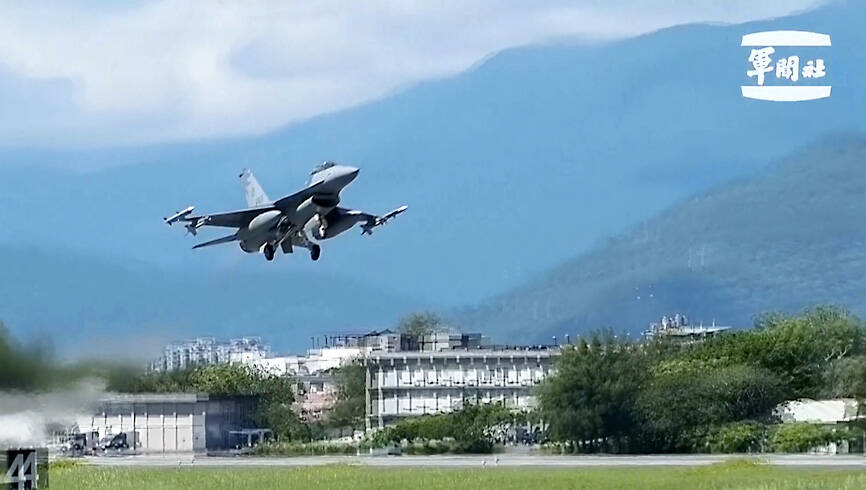The air force should intercept and drive away Chinese warplanes and warships as soon as they reach Taiwan’s outlying islands or the median line of the Taiwan Strait, rather than monitoring or responding only when the enemy is too close, a former air force deputy commander said on Sunday.
The Chinese People’s Liberation Army’s (PLA) Eastern Theater Command on Saturday said that a “joint naval and air war-readiness patrol” would be launched around Taiwan that same day.
The announcement was made one day after Vice President William Lai (賴清德) returned from a trip to Paraguay, which included stopovers in the US.

Photo: Taiwan Military News Agency via AP
From 6am on Saturday to 6am on Sunday, 45 of the PLA’s warplanes and nine of its warships were detected around Taiwan, Ministry of National Defense data showed.
Of the aircraft, 27 crossed the median line of the Taiwan Strait: nine Su-30, four J-11 and 12 J-10 fighters, as well as one Y-9 military transport aircraft and one Z-9 utility aircraft. The Y-9 and Z-9 advanced farther than the fighters, entering Taiwan’s southwest air defense identification zone, the ministry said.
Retired lieutenant general Chang Yen-ting (張延廷) said the military exercises were different from previous sorties.
“This time, the military exercises were launched on the same day that the announcement was made. Unlike previous ones, they did not announce in advance the coordinates of the areas where military exercises would be conducted and how long they would last. This could be the new norm,” Chang said.
Video footage of the military exercises released by official Chinese media mainly showed images of the navy and air force, not of the army and its Rocket Force, meaning the PLA is focused on air and sea supremacy, Chang said.
The PLA also released videos in which it stressed its capabilities in conducting military exercises in waters very close to Taiwan proper, he said.
“They are conducting military exercises and propaganda at the same time. Long before the military exercises began, they were prepared to conduct cognitive, psychological and media warfare along with the military drills,” Chang said.
China was playing the same old tune when justifying its actions, as the exercises targeted pro-Taiwan independence forces, he added.
The video that Taiwan’s navy produced to counter China’s cognitive warfare would only have a limited effect, Chang said.
“We allowed warships to come very close to the contiguous zone and are only guarding the 12 nautical miles [22km] of territorial sea. Chinese warships would not be driven away unless they reached the median line. A complete lack of deep defense strategy would only allow the enemy to push further and intrude on our territory. Such a video would not produce much of an effect,” he said.
The strategy of surveilling and only driving away Chinese warplanes and warships when they are close is problematic, he said.
“Instead of responding in advance while the enemy is still far away, our surveillance begins only when they are already at our doorstep. A response at the last line of defense would only expose our shortcomings,” Chang said.

Chinese Nationalist Party (KMT) Chairman Eric Chu (朱立倫), spokeswoman Yang Chih-yu (楊智伃) and Legislator Hsieh Lung-chieh (謝龍介) would be summoned by police for questioning for leading an illegal assembly on Thursday evening last week, Minister of the Interior Liu Shyh-fang (劉世芳) said today. The three KMT officials led an assembly outside the Taipei City Prosecutors’ Office, a restricted area where public assembly is not allowed, protesting the questioning of several KMT staff and searches of KMT headquarters and offices in a recall petition forgery case. Chu, Yang and Hsieh are all suspected of contravening the Assembly and Parade Act (集會遊行法) by holding

PRAISE: Japanese visitor Takashi Kubota said the Taiwanese temple architecture images showcased in the AI Art Gallery were the most impressive displays he saw Taiwan does not have an official pavilion at the World Expo in Osaka, Japan, because of its diplomatic predicament, but the government-backed Tech World pavilion is drawing interest with its unique recreations of works by Taiwanese artists. The pavilion features an artificial intelligence (AI)-based art gallery showcasing works of famous Taiwanese artists from the Japanese colonial period using innovative technologies. Among its main simulated displays are Eastern gouache paintings by Chen Chin (陳進), Lin Yu-shan (林玉山) and Kuo Hsueh-hu (郭雪湖), who were the three young Taiwanese painters selected for the East Asian Painting exhibition in 1927. Gouache is a water-based

Taiwan would welcome the return of Honduras as a diplomatic ally if its next president decides to make such a move, Minister of Foreign Affairs Lin Chia-lung (林佳龍) said yesterday. “Of course, we would welcome Honduras if they want to restore diplomatic ties with Taiwan after their elections,” Lin said at a meeting of the legislature’s Foreign Affairs and National Defense Committee, when asked to comment on statements made by two of the three Honduran presidential candidates during the presidential campaign in the Central American country. Taiwan is paying close attention to the region as a whole in the wake of a

OFF-TARGET: More than 30,000 participants were expected to take part in the Games next month, but only 6,550 foreign and 19,400 Taiwanese athletes have registered Taipei city councilors yesterday blasted the organizers of next month’s World Masters Games over sudden timetable and venue changes, which they said have caused thousands of participants to back out of the international sporting event, among other organizational issues. They also cited visa delays and political interference by China as reasons many foreign athletes are requesting refunds for the event, to be held from May 17 to 30. Jointly organized by the Taipei and New Taipei City governments, the games have been rocked by numerous controversies since preparations began in 2020. Taipei City Councilor Lin Yen-feng (林延鳳) said yesterday that new measures by